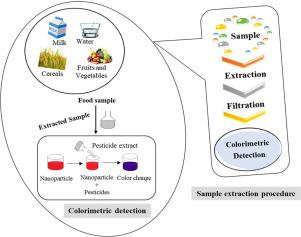Trends in Environmental Analytical Chemistry ( IF 11.1 ) Pub Date : 2020-02-27 , DOI: 10.1016/j.teac.2020.e00086 Rajat Singh , Naveen Kumar , Rahul Mehra , Harish Kumar , Vijay Pal Singh

|
Pesticides are generally used to control and prevent agricultural pests. Excessive and sporadic use of pesticides poses a serious threat to human and livestock life. Therefore, to safeguard the people’s health simple and sensible approaches for the determination of residual pesticides in food items are desperately required. The nanotechnology-based colorimetric approaches provide the options for detection of residual pesticides with high precision and speed. Localized surface plasmon resonance (LSPR) is one of the most prominent features of metal nanoparticles which provides unique optoelectronic characteristics in the visible region of the electromagnetic spectrum. Metal nanoparticles especially gold and silver have very high extinction coefficients, therefore a well-suited electrochemical interaction between target analytes and nanoparticles surfaces cause aggregation, which leads to a colorimetric response. Modification and functionalization of nanoparticles with other ligands enhances the sensitivity and selectivity of colorimetric assays. But still, there are major challenges which affect the efficacy of these techniques for onsite pesticides monitoring which need to be addressed. Therefore, a comprehensive review of progress and challenges in the application of nanotechnology-based colorimetric techniques for detection of residual pesticides is presented here. The mechanism behind the development of these analytical techniques is also discussed, briefly. In conclusion, potential future trends and prospects of colorimetric techniques are addressed.
中文翻译:

基于纳米技术的比色技术在残留农药检测中的进展与挑战
农药通常用于控制和预防农业害虫。过度和零星使用农药对人类和牲畜生命构成严重威胁。因此,为了保护人们的健康,迫切需要一种简单而明智的方法来测定食品中的残留农药。基于纳米技术的比色方法为高精度检测残留农药提供了选择。局部表面等离子体激元共振(LSPR)是金属纳米颗粒的最突出特征之一,它在电磁光谱的可见光区域提供独特的光电特性。金属纳米粒子,尤其是金和银,具有很高的消光系数,因此,目标分析物和纳米颗粒表面之间的良好电化学相互作用会导致聚集,从而导致比色响应。用其他配体对纳米颗粒进行修饰和功能化可提高比色测定的灵敏度和选择性。但是,仍然存在一些主要挑战,这些挑战影响了这些技术在现场农药监测中的功效,需要解决。因此,这里介绍了基于纳米技术的比色技术在残留农药检测中的应用进展和挑战的全面综述。还简要讨论了这些分析技术发展的机理。总之,解决了潜在的未来趋势和比色技术的前景。导致比色反应。用其他配体对纳米颗粒进行修饰和功能化可提高比色测定的灵敏度和选择性。但是,仍然存在一些主要挑战,这些挑战影响了这些技术在现场农药监测中的功效,需要解决。因此,这里介绍了基于纳米技术的比色技术在残留农药检测中的应用进展和挑战的全面综述。还简要讨论了这些分析技术发展的机理。总之,解决了潜在的未来趋势和比色技术的前景。导致比色反应。用其他配体对纳米颗粒进行修饰和功能化可提高比色测定的灵敏度和选择性。但是,仍然存在主要挑战,这些挑战影响了这些技术在现场农药监测中的功效,需要解决。因此,这里介绍了基于纳米技术的比色技术在残留农药检测中的应用进展和挑战的全面综述。还简要讨论了这些分析技术发展的机理。总之,解决了潜在的未来趋势和比色技术的前景。但是,仍然存在一些主要挑战,这些挑战影响了这些技术在现场农药监测中的功效,需要解决。因此,这里介绍了基于纳米技术的比色技术在残留农药检测中的应用进展和挑战的全面综述。还简要讨论了这些分析技术发展的机理。总之,解决了潜在的未来趋势和比色技术的前景。但是,仍然存在一些主要挑战,这些挑战影响了这些技术在现场农药监测中的功效,需要解决。因此,这里介绍了基于纳米技术的比色技术在残留农药检测中的应用进展和挑战的全面综述。还简要讨论了这些分析技术发展的机理。总之,解决了潜在的未来趋势和比色技术的前景。还简要讨论了这些分析技术发展的机理。总之,解决了潜在的未来趋势和比色技术的前景。还简要讨论了这些分析技术发展的机理。总之,解决了潜在的未来趋势和比色技术的前景。









































 京公网安备 11010802027423号
京公网安备 11010802027423号